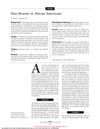Ethnic Considerations in Hair Restoration Surgery
July 2014
in “
Facial Plastic Surgery Clinics of North America
”
hair restoration surgery ethnic differences hair traits hair transplants hair thickness color contrast follicle shape eyebrow transplants scalp transplants curly hair follicular unit extraction FUE hair density hairline design recipient sites beard grafting graft counts facial hair areas eyebrow restoration eyelash restoration hairline lowering grafting surgical hairline advancement SHA FUG strip method

TLDR Different ethnic hair traits must be considered for successful hair restoration surgery to achieve natural-looking results.
The document from 2014 emphasizes the significance of considering ethnic differences in hair traits when performing hair restoration surgery. It notes that Asian and African ethnicities have distinct hair characteristics that influence the outcome of transplants, such as hair thickness, color contrast, and follicle shape. African patients often benefit from eyebrow and scalp transplants due to their curly hair and minimal color contrast, while Asian hair's round follicles and metabolic activity present unique challenges. Follicular unit extraction (FUE) is the preferred method for these groups, and hair density varies among ethnicities. The document also covers the design of hairlines and recipient sites, stressing the importance of realistic expectations and ethnic considerations for natural-looking results. Additionally, it discusses the popularity of beard grafting in American men, the specifics of graft counts for facial hair areas, and the techniques for eyebrow and eyelash restoration. Hairline lowering can be achieved through grafting or surgical hairline advancement (SHA), with SHA being popular among African patients. Overall, the document concludes that the choice of technique (FUG/strip or FUE) and careful planning are crucial for successful hair restoration surgery that takes into account ethnic hair characteristics.




